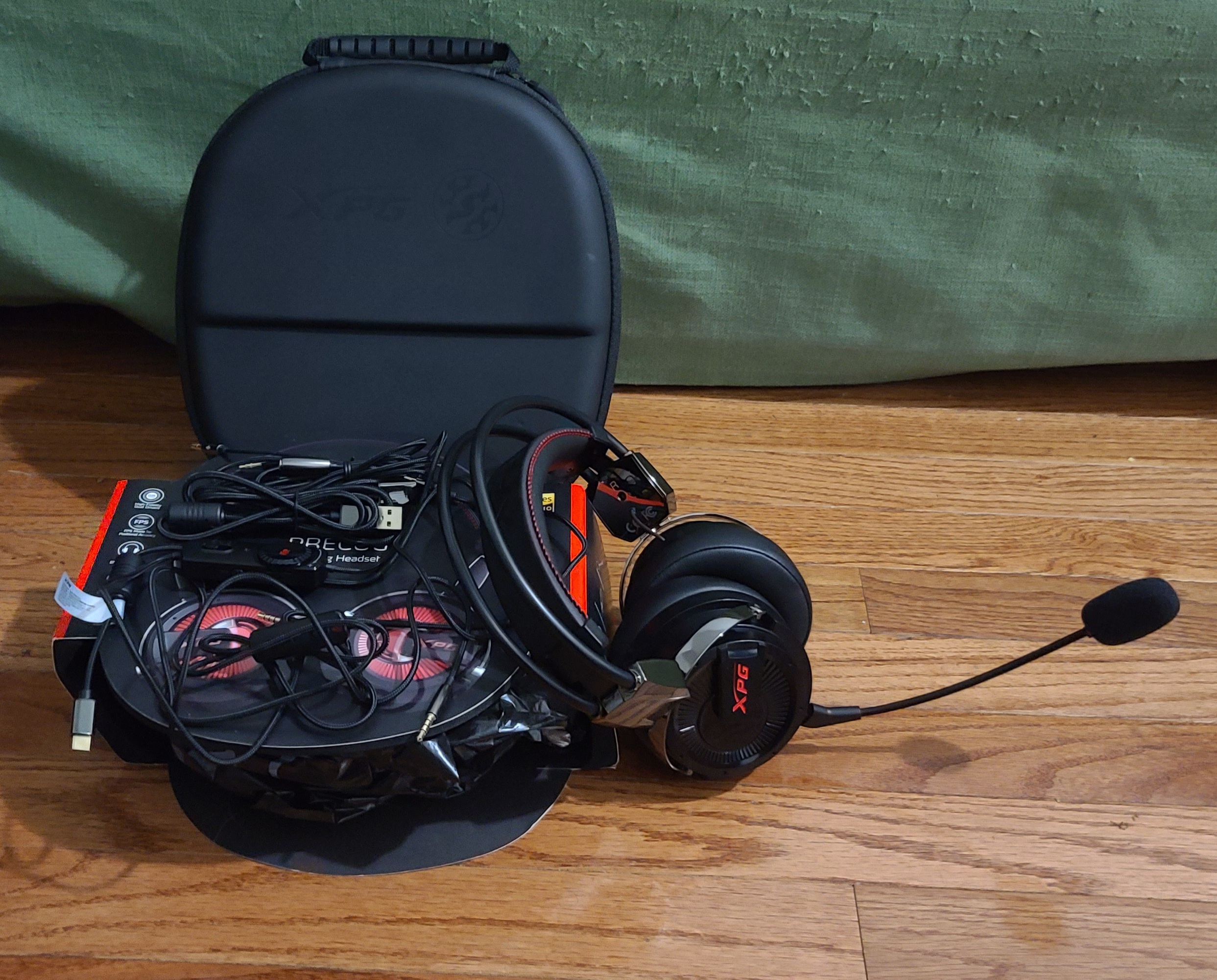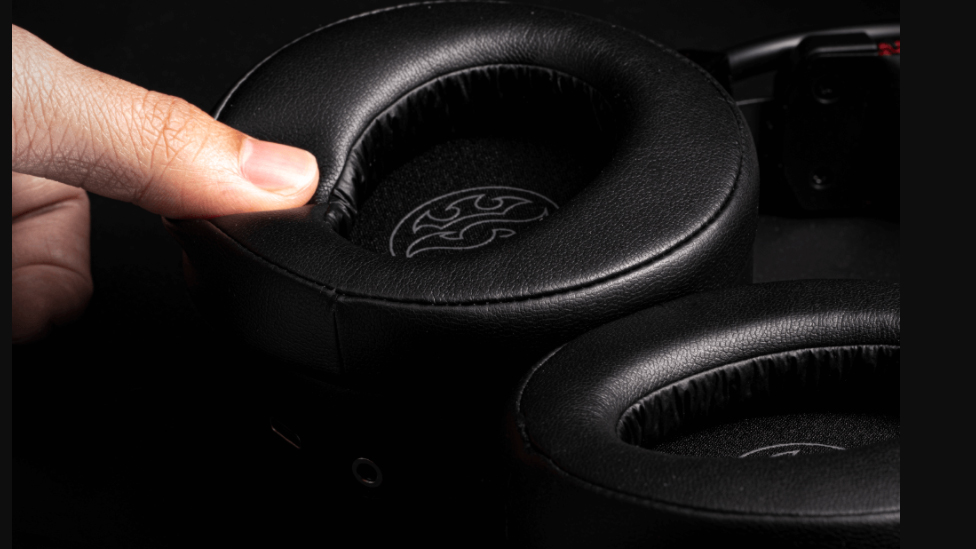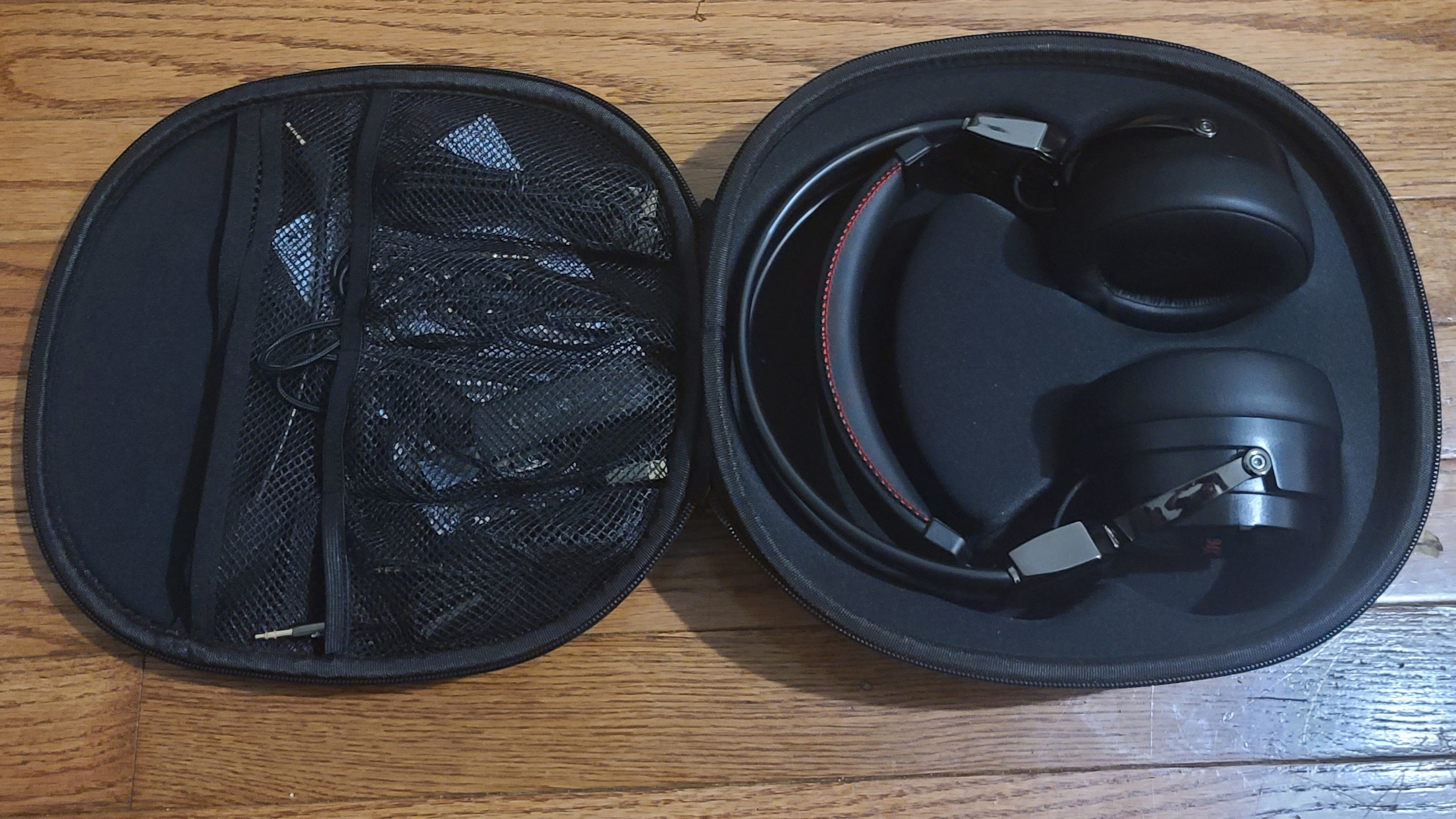Tom's Hardware Verdict
XPG comes out swinging with an affordable headset that offers superior sound quality in both its drivers and its mic –- as long as it is connected via USB. Three different voicings ensure that the Precog offers a solid experience whether you are listening to music, watching movies or gaming.
Pros
- +
Audio is well balanced and very loud
- +
Excellent mic and noise cancelation
- +
Good build quality
- +
Ample connectivity options
Cons
- -
"Auto-adjust" headband
- -
Poor audio quality and volume via 3.5mm connection
Why you can trust Tom's Hardware
If you’re looking for the best gaming headset that can do it all, it may make sense to get a pair of cans with multiple connectivity options. That way, you can use it with a USB connection for PC or move to a 3.5mm connection with other device types, such as consoles.
Adata’s XPG Precog gaming headset ($99.99 as of writing) fits that bill, connecting over USB Type-C, USB Type-A via an adapter or 3.5mm while offering strong drivers and an excellent mic. But while it’s a worthy USB headset, the 3.5mm experience leaves a lot to be desired.
XPG Precog Specifications
| Driver Type | Electrostatic/dynamic dual-drivers | Row 0 - Cell 2 |
| Impedance | 32 Ohms | Row 1 - Cell 2 |
| Frequency Response | 5 – 50,000Hz | Row 2 - Cell 2 |
| Microphone Type | Bidirectional, noise cancelling, detachable | Row 3 - Cell 2 |
| Connectivity | USB-C, USB Type-A (via USB-C to USB-A adapter), 3.5mm | Row 4 - Cell 2 |
| Weight (With mic) | 0.8 pounds (362g) | Row 5 - Cell 2 |
| Cables | USB-C (4.3 fee /1.3m); 3.5mm (4.1 feet/1.3m), USB-A to USB-C (4.1 feet/1.3m); Y-cable splitter (4.5 feet/1.4m) | Row 6 - Cell 2 |
| Lighting | Red LED | Row 7 - Cell 2 |
| Software | None | Row 8 - Cell 2 |
Design and Comfort of XPG Precog

The XPG Precog is a rugged-looking piece of hardware, featuring hefty earcups mounted to a metal bracket and connected via a pair of thick cords running parallel to the auto-adjusting leatherette headband. The earcups are finished in a deep matte black and accented by a red LED and accompanying red XPG logo. This contrasts nicely with the high metallic gloss of the mounting bracket, giving the Precog an aggressive look that says ‘ready for war.’ The Precog’s overall look squarely aims at gamers. This headset clearly wasn’t intended to chill out in your cubicle.
The XPG Precog’s earcups offer plenty of cushioning and depth, so your ears won’t be crushed against the drivers. This makes the cans great for long play sessions. Additionally, you can swivel the earcups, allowing the headset to rest comfortably on your neck during breaks.
The Precog is sturdy without feeling like a burden. It weighs in at 0.8 pounds, the same weight as the Riotoro Aviator Classic, which also offers 3.5mm or USB (Type-A only) connectivity for about the same price. The similarly priced Razer BlackShark V2, however, (USB-A or 3.5mm connection) is a lighter 0.6 pounds.
Unfortunately, XPG opted for what it describes as an “auto-adjust” headband, instead of allowing you to adjust the headband to your own liking. The Precog’s headband does feel tighter and less slippery than that of similar offerings from competitors, but it never felt quite right regardless of where it sat on my head.
XPG offers a number of connectivity options, alongside a standard USB Type-C connection. You also get a USB-C to USB-A connector in case you don’t have an available USB-C port. There’s also a 3.5mm connector and a Y cable splitter. Overall, you’re getting compatibility with all three major consoles and Android smartphones in addition to gaming PCs. The cables themselves are braided and sturdy. Attached to the USB-C cable is an inline DAC that also houses the device controls, allowing you to adjust volume, mute/unmute the mic, turn Environmental Noise canceling on and off, toggle the LED on/off and switch between three audio modes (music, virtual 7.1 surround sound and FPS).
A special mention should also be paid to XPG’s packaging for the Precog. The headset comes packaged in its own lightweight, black hard carrying case that feels like fake leather and includes neat internal compartments for each of the Precog’s cables. This is a really nice, convenient and waste=reducing touch that I’d love to see other companies in the gaming peripheral space adopt.
Audio Performance of XPG Precog

The XPG Precog distinguishes itself from competing headsets by offering both an electrostatic driver and dynamic driver in each earcup, a rarity for gaming headsets. The electrostatic driver aims for clean, crisp and distortion-free output of high and low frequencies, while the dynamic drivers handle low to mid-range audio.
The Precog’s drivers boast an extremely wide frequency response of 5 – 50,000 Hz. For comparison, Riotoro’s Aviator Classic range is 20 - 20,000 Hz and Razer’s BlackShark V2’s is 12 - 28,000.
XPG’s headset is noticeably louder than the speakers in many other gaming headsets. Ultimately, audio was crisp and clear and did not suffer from breakup at higher volumes. Still, you may want to lower the volume for your own sake because these cans pack a significant punch.
I chose DOOM, CS:GO and Dark Souls 3 as my test titles for gaming because of their excellent directional sound design. For testing purposes, I toggled between the headset’s virtual 7.1 surround sound mode and FPS mode, and the differences were striking.
In 7.1 mode, bass frequencies got a significant boost, and the overall volume increased a fair amount. This increase in volume combined with the low frequency boost can make the overall soundscape a little overwhelming, During calmer moments of gameplay, 7.1 sounded great, but when a frantic firefight broke out the clarity sometimes suffered.
FPS mode dialed back the volume and the bass frequencies, providing a much cleaner and focused audio experience. This mode really did a good job of highlighting directional audio cues. Compared to the sensory overload I experienced in 7.1 mode, FPS mode helped me focus on the aural details that matter by filtering out the excess noise.
The Precog’s FPS mode can be very useful in competitive titles; however, I would not recommend FPS mode for a movie experience as it tends to make audio sound a little brittle in comparison.
Meanwhile, the 7.1 mode would be a great fit for horror games, where an enveloping feeling of dread is critical. Pitched battles in films with surround sound, like The Lord of the Rings: Return of the King, also sounded excellent in 7.1 mode.
I spent several hours listening to a variety of music genres, ranging from hip hop to extreme metal, on the Precog using the Music setting and was pleased with the even frequency response, volume and clarity. Bass sounded tight and punch, mids were muscular and highs sounded pronounced without becoming shrill.
Things weren’t all rosy, however. When I used the Precog with its 3.5mm connection and, therefore, without using the onboard DAC, the headset lost some serious oomph. The drop in volume and loss of aural definition was very noticeable, to the point where I can not recommend using the Precog this way unless you have no other choice. Further exacerbating this issue is the fact that Environmental Noise Canceling can't be used with a 3.5mm connection, so you’re giving up a useful feature in addition to sound quality. This is a particular sad state of affairs for those hoping to use the Precog with a console.
Microphone on XPG Precog
The Precog’s mic is the real star of the show. It offers a frequency response of 20-20,000 Hz and sounds clear and full, never dipping into the nasal territory found in many other gaming headset mics. XPG gets credit for including a pop filter on the mic that does an excellent job of keeping consonants from exploding.
Additionally, the cans’ mic has Environmental Noise Canceling (ENC) that’s fairly impressive. With ENC off, my teammates could still hear the chattering of the clicky Cherry MX Blue mechanical switches on my best gaming keyboard over my voice. When I turned ENC on, there was a significant decrease in the volume of my clicky beauties. Monitoring the difference in OBS showed a noise reduction of roughly -5dB, and this occurs without unduly compromising the sound of the mic or significantly altering the EQ curve.
Features and Software of XPG Precog
XPG does not currently offer a software suite to compliment the Precog – only a simple utility to update the ENC firmware for the Precog’s microphone. All headset functionality is controlled via the controls mounted on the Precog’s inline DAC. We were able to enjoy the Precog with its out-of-box settings, but the lack of software will be a drawback for those who want to tweak the headset’s performance.
Bottom Line

XPG has put together an impressive package in the Precog gaming headset. It combines a wealth of connectivity options with solidly voiced and loud drivers and an excellent mic that really delivers on noise cancelation for a very fair price.
Unfortunately, the Precog does not fare well when using the 3.5mm cable to connect. Audio quality and volume suffer significantly without the USB connector’s powerful DAC, and with any 3.5mm connection you won't be able to use ENC, which happens to be of the Precog’s most impressive features. This means that gamers who wish to use this headset with their Xbox are left wanting.
I’m also somewhat perplexed by Adata’s choice of going with an auto-adjust headband instead of a standard self-adjusting one. The headband’s more comfortable than some others by virtue of having a tighter fit, but the "one size fits all" mentality works for socks, not headsets. For other options with both USB and 3.5mm, there’s the very cozy Razer BlackShark V2, more traditional Riotoro Aviator Classic and colorful HyperX Cloud Alpha (none connect via USB-C though).
The XPG Precog is a great value, as long as it is used with its USB DAC, making it an excellent choice for PC, Nintendo Switch and PS4 gamers. Xbox gamers will want to look elsewhere, but three out of four isn’t bad at all. For those who can get the most out of the XPG Precog, it delivers.

Nate Rand is a freelance reviewer for Tom's Hardware US, covering gaming headsets, keyboards, mice, and microphones.